Last Updated on October 26, 2023
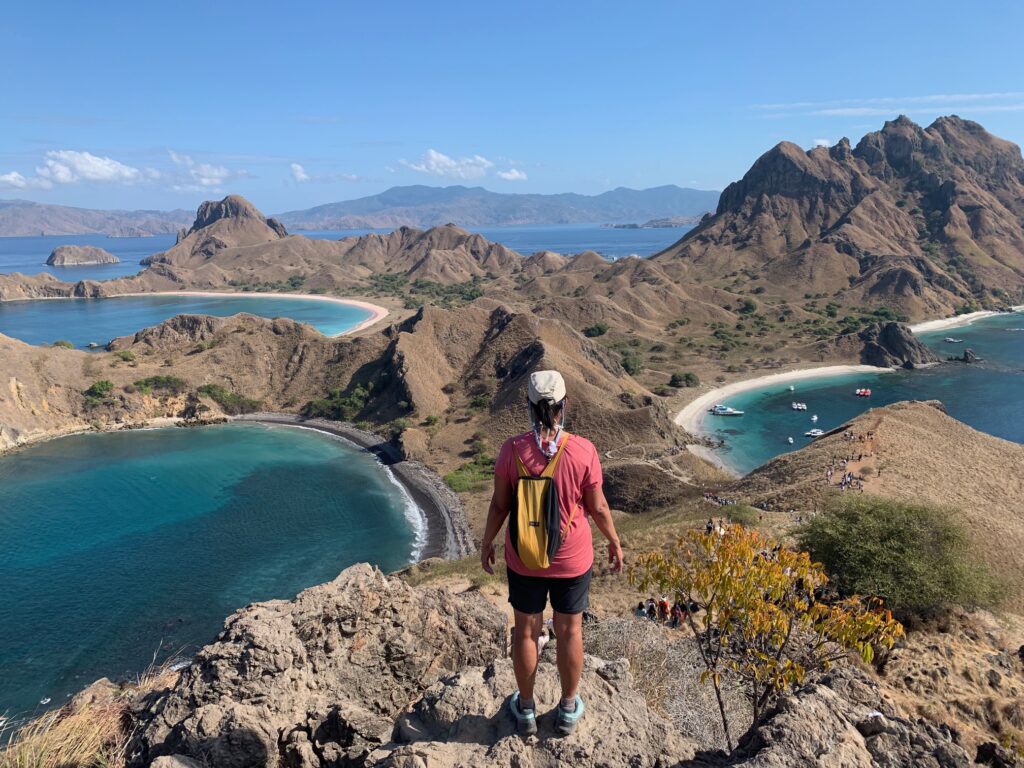

Flores is mostly an undeveloped island in the middle of Indonesia. We spent 14 blissful days in July 2023 in Flores and it was an unforgettable experience. For the most part, the people are warm, happy and accepting of foreign visitors. Some will even greet you first and ask you “where are you from?”
There are many attractions in Flores and we barely scratched the surface during our stay. Most notable are the Kelimutu lakes, beautiful Koka beach, 17 Islands National Park and Komodo National Park. Here we describe our experience in Flores including where we stayed and how we got around the island.
Getting Around Flores
We planned to just ride the public buses in Flores to get from one town to another. The buses are the cheapest transportation but it takes a long time to get from point A to B because of the many stops as it needs to pick up and drop off passengers.
Then we found out from our first host that the most efficient way of getting around Flores is riding what locals call “public”. This name is actually misleading as these are actually private vehicles that shuttle people from one town to another. These vehicles are primarily SUV type or minivan type vehicles with three rows of seating. If you are a big fella, you may feel a little cramped if you get assigned to the 3rd row. It is also beneficial if you are not lugging a large suitcase as bag space is limited. Some will tie the luggage on top of the roof without a roofrack so you pray to god that your luggage is still there when you get to your destination.
Other challenges with “public” is finding their station or location where they pick up passengers and their schedule. These vehicles are not marked so you would not be able to distinguish them from a true private vehicle. Another disadvantage is that some drivers will just roll the window and light up smoke so you may have to put up with it for the duration of the trip.
The best way of traveling in Flores is getting on one of the buses or Sprinter type vans operated by Pariwisata. Pariwisata runs between Maumere and Labuan Bajo. Our host in Ruteng arranged our Pariwisata ride from Ruteng to Labuan Bajo. The cost was the same as the “public” transport but the ride was so much better. We only had to pay an extra 10K IDR to be picked up from our accommodation.
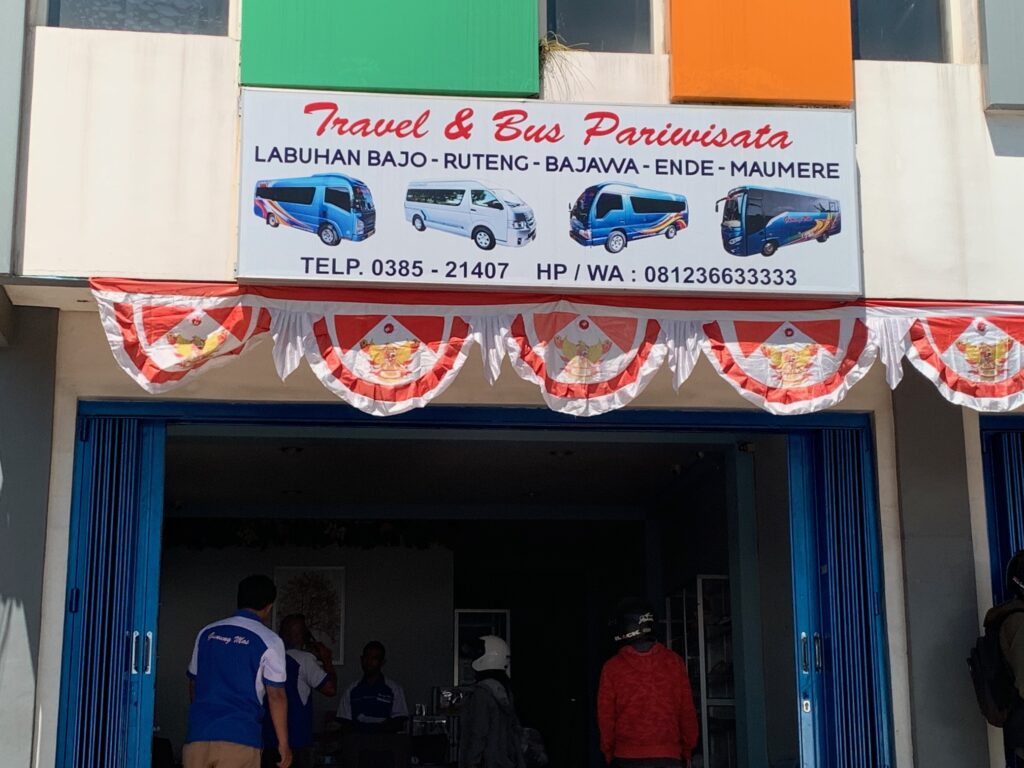

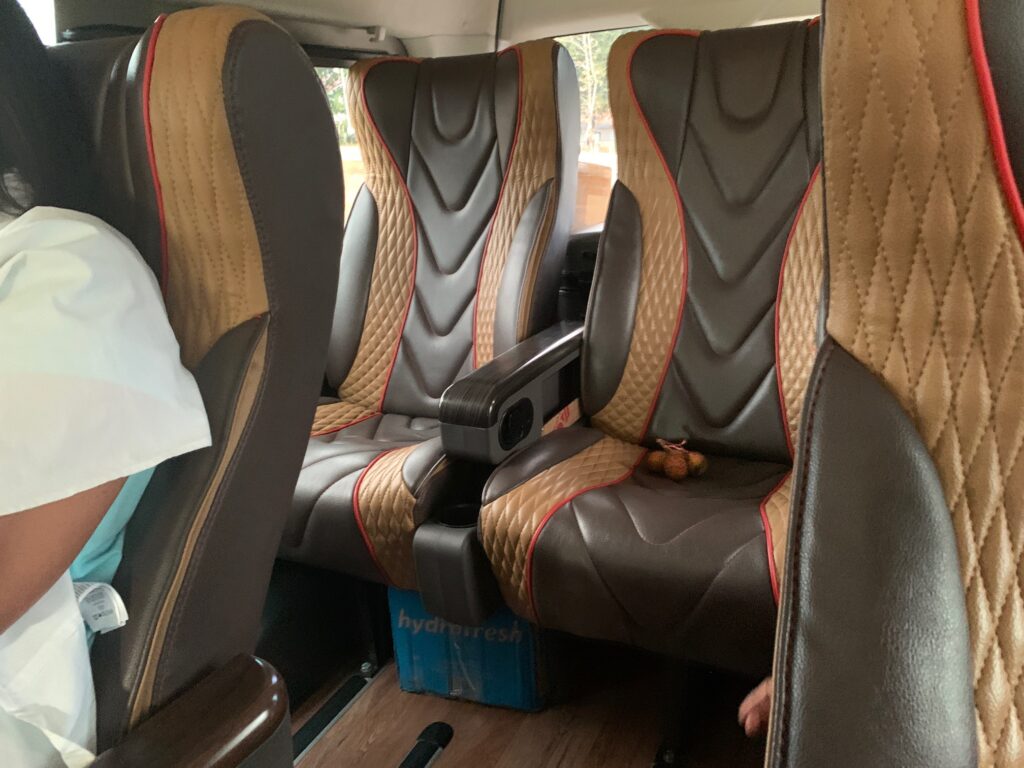

Given all of the above information, you may be wondering how would you go about setting up your Flores transportation. It is best to arrange it through your accommodation host ahead of time. Your host will even find a motorcycle for you if you requested one. Our first stop in Flores was Moni and we WhatsUp messaged our host asking how we would get from the City of Ende to Moni. Our host said he would pick us up and his price was reasonable. To us this was the right decision. It may be a little higher than “public” but at least we would get to our destination on our first night.
If you do not want to handle the logistics of exploring Flores, there are private tour guides that can take you around the entire island. Their services range from just driving you around to the different places you want to see to driving plus booking all accommodations. Price depends on the level of service. We were told by a couple that contracted such service that it costs around 1.1M IDR per day.
You may be wondering if the tour guide eat and stay with you in the accommodation. The answer is it depends on your arrangements but for the most part, these tour guides eat and sleep separately from their clients.
Your next question might be how can you find these tour guides? A couple from France said that they learned about their guide through a taxi driver. You will also get some hits if you Google “Flores Tour Guides”. That is all we know about tour guides as we did not use their services.
Moni and Kelimutu LakeS
Moni is a small town at the base of Kelimutu mountain. It is high in elevation so it is cooler in temperature compared to sea level. Moni has a couple of restaurants, some warungs, local stores where you can purchase bottled water and snacks and a few homestays. Most tourists go to Mopi’s Place to have a drink or meal. There are other things to do in Moni besides going to Kelimutu. There are hot springs, waterfalls, treks and recently discovered healing water according to our homestay host. We met a family that spent four nights in Moni and were able to fill their time doing all kinds of explorations.
The Kelimutu Three Lakes Complex is within a national park. There is a 150K IDR per person entry fee plus 10K for the vehicle. The three separate lakes have different colors but only two get the most attention. Tiwu Ata Polo has a deep blue color that changes to greenish blue when hit by the sun’s rays in the morning. The other is Tiwu Nuwa Muri Koo Fai which has a bluish green color but changes to turquoise when hit by the sun.
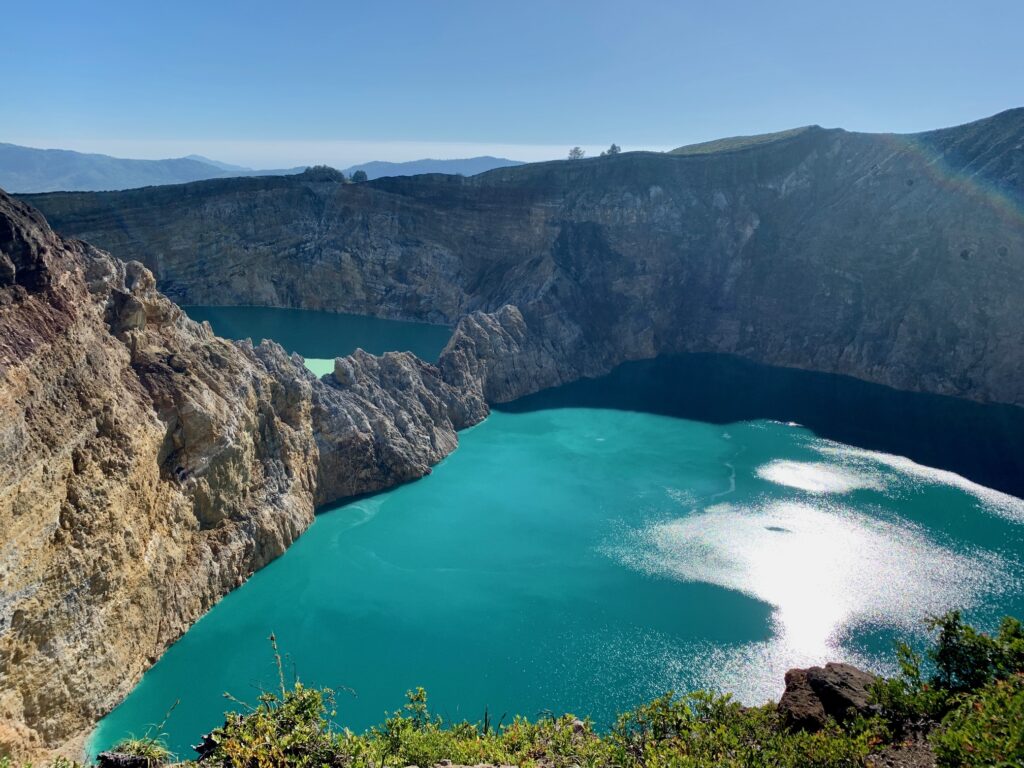

We contracted our host to drive us to the park. We could have rented a motorcycle and rode there but passed on the idea. Our host said that most people wake up at 4 AM in the morning to get up to the viewing area before sunrise. Not us. We left Moni at 5:30 AM and reached the parking lot around 6:30 AM. Then it is about a 30 minute hike on some series of steps to get to the viewing area. Most visitors that came early for the sunrise were on their way down as we were going up. So we had the place to ourselves for a good hour until we decided to leave around 8AM. We waited for the sun to hit the lake so we could see the contrasting colors. We could have spent longer if it wasn’t for the sun warming us up.
Koka Beach
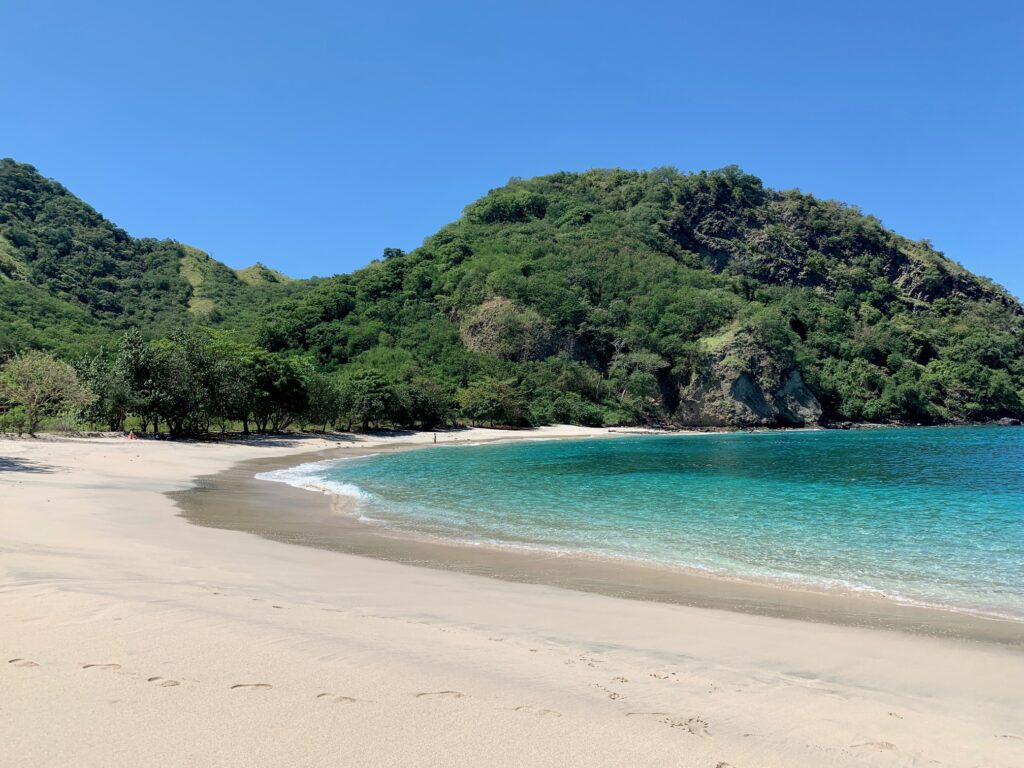

We contracted our host again to drive us to Koka Beach from Moni. Koka Beach is about an hour and half drive from Moni. The highway to get to Koka Beach is winding and slow going. Then there is about a kilometer and a half of partly rough and partly paved narrow road to get to the beach. There is no sign to the beach from the main road. There are also two entry fees that must be paid. One just after turning from the main road and the other is at the beach. Each entry fee is collected by locals and costs 20K each per vehicle.
There are two beaches in Koka Beach. Both are crescent shaped and about 400 meters long. The water is light blue in color and the beach has a relatively steep slope (somewhere between 10 and 15 percent). The water can have waves crashing one minute and calm the next. We arrived when the water was going from high tide to low tide. Above the waist, the oncoming waves were strong enough to push us backwards or drag us back into the water when it receded.
But there was no current once we were further out in the water. The bottom is a combination of rocks and sand. There are no significant corals in the beach so there is minimal marine life.
Koka Beach is not the place for snorkeling. It is more conducive for just lying on the beach under a tree or sun and just having an idle time. There is a restaurant that serves good food at a reasonable price. They also have tables and chairs underneath the trees which is perfect for enjoying a cold drink.
Bajawa
Getting to Bajawa From Moni
Our next stop was Bajawa after Moni, through Ende. Initially, Bajawa was just going to be a transition point on the way to Riung as the travel time from Moni>Ende>Riung would be too long. (Later we heard from other travelers that there are “public” from Moni to Riung without going through Ende and Bajawa)
We were going to catch a “public” from Moni to Ende then another “public” from Ende to Bajawa. Our host was going to Ende so he gladly gave us a ride, otherwise he said he would flag a “public” that goes from Maumere to Ende. At Ende, our host dropped us off a the “public” station that goes between Ende and Bajawa.
What To See And Do In Bajawa
Initially, we did not know that there are plenty of things to see and do in Bajawa until we talked to other travelers. We knew Bajawa has hot springs but did not know there are traditional villages, a cone shaped mountain and a wonderful viewpoint. So we cut short our Riung stay by one day so we can spend more time in Bajawa.
We basically had two days to explore Bajawa. We went to the Luba and Bena traditional villages, had lunch at the Manulalu Restaurant which has a good view of Mount Inerie, the Malanage Hot Springs, Air Terjun Ogi (Ogi waterfall) and Wolobobo Viewpoint.
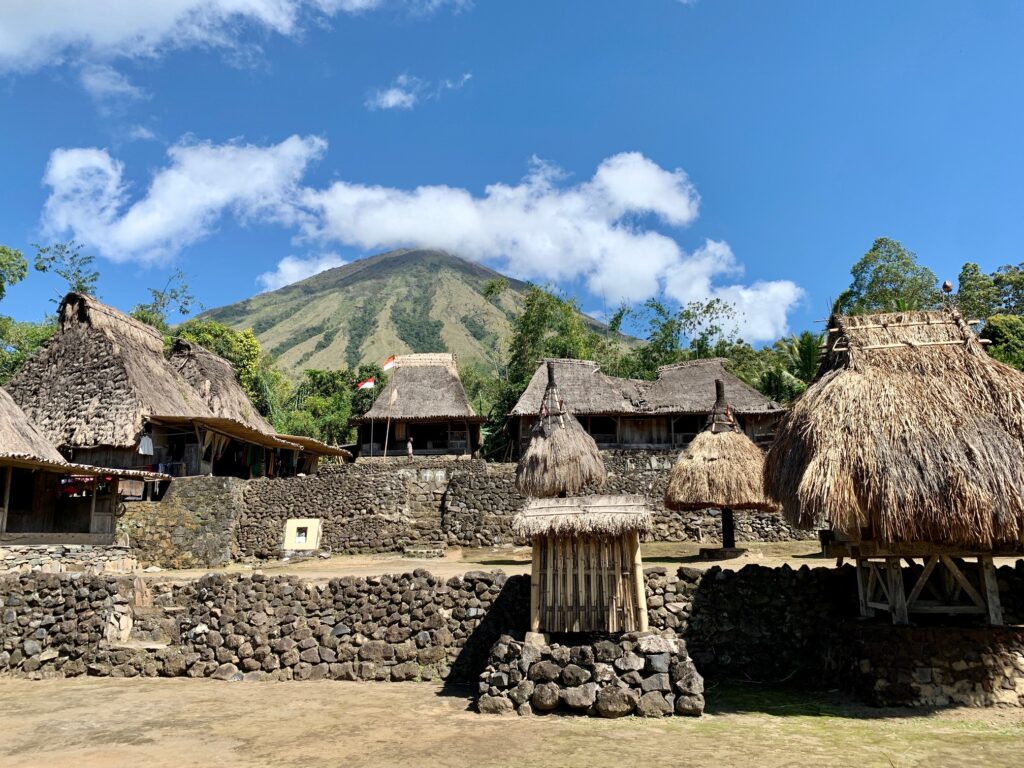

Luba traditional village is the smaller version of Bena. It is free to roam around Luba. But for Bena, there was a 25K per person admission plus a 3K motorcycle parking fee. Manulalu Restaurant is perched on the side of the mountain and has a panoramic view of the valley below as well as the cone shaped Mount Inerie, the tallest mountain in Flores. Most tour guides take their clients here for lunch after exploring Luba and Bena traditional villages.
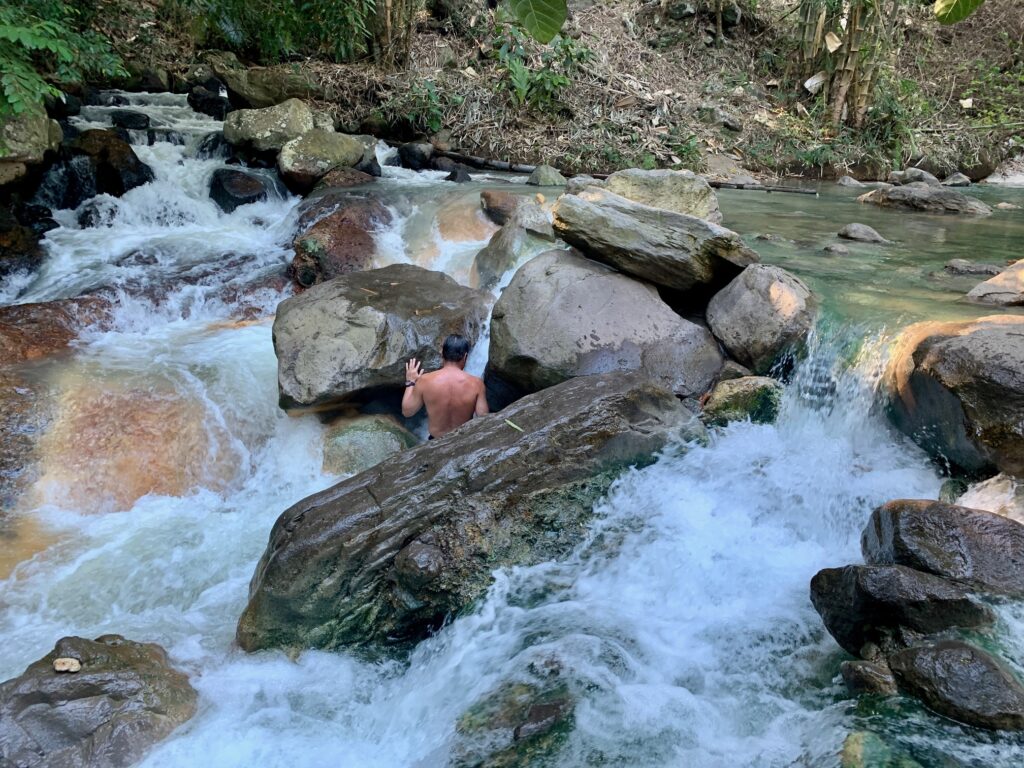

Manalage Hot Springs are not really springs. It is the confluence of two rivers, a cold river and a very hot river. Most people hang around where the two rivers meet. You can get a warm hydromassage that way as the water cascades over boulders. Another hot spring that some people visit from Bajawa is Sua Hot Springs. It is north and east of Bajawa and much further than Manalage Hot Springs.
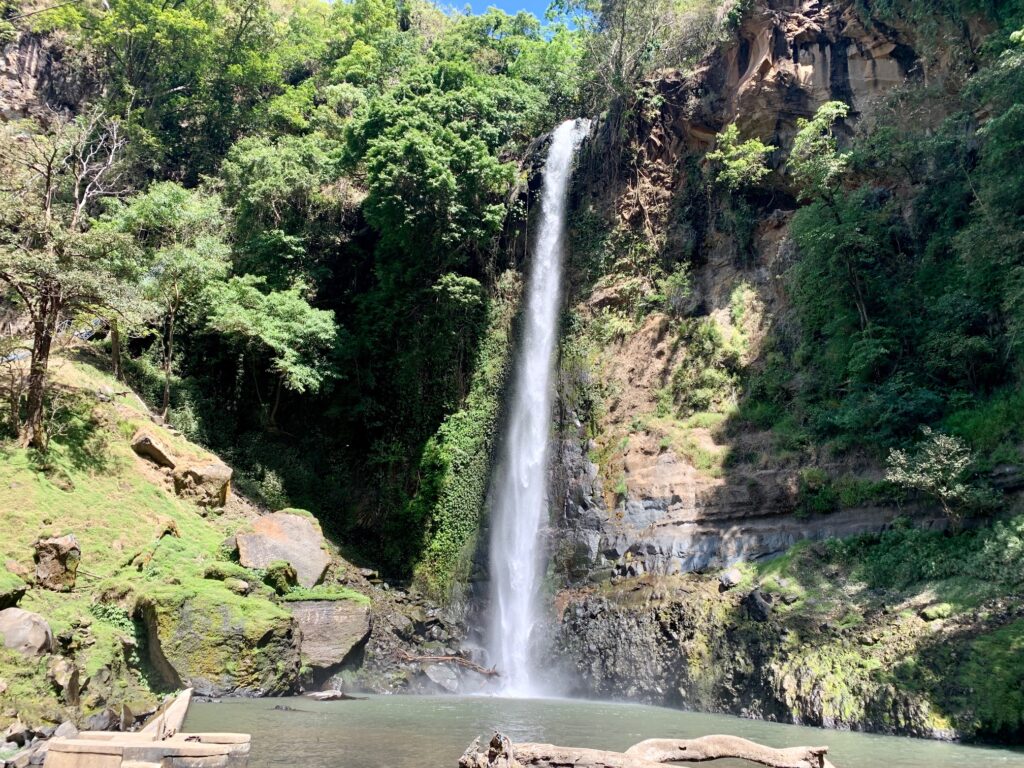

Air Terjun Ogi is less than a 30 minutes motorbike ride from Bajawa. You have to motorbike a rutted motorcycle trail for about two kilometers from the main road before reaching the parking area. Then it is a short walk to see the waterfall take a 70 or so foot plunge.
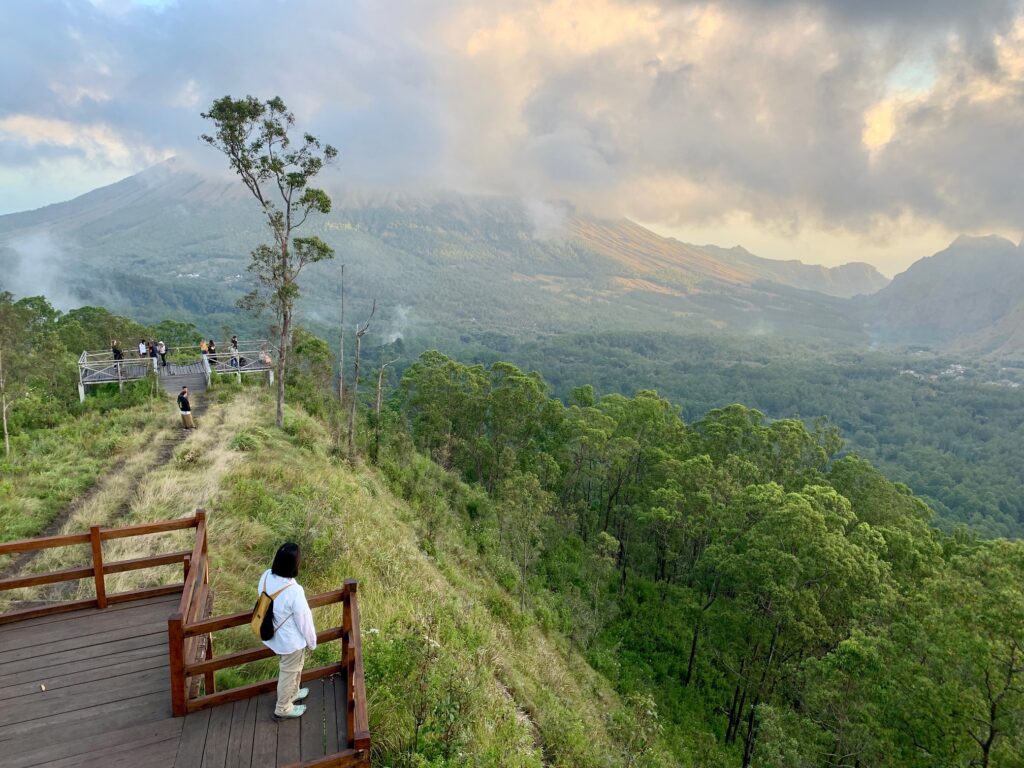

Perhaps the place that must not be missed in Bajawa is the Wolobobo Viewpoint. It has a picturesque view of Mount Inerie as well as the valley below. Clouds and fog could roll in at any day just like what happened to us. Go to Wolobobo if it is a clear day because it may not be clear tomorrow or even a few hours later. Local guides also take their clients to Wolobobo for the sunset.
From Bajawa, GoogleMaps told us to exit the Bajawa-Ende road and take the road going to the Bela and Bena traditional villages. Then it wanted us to use a very bad (condition-wise) road less than two kilometers after making the turnoff from the Bajawa-Ende road. The best way to reach the viewpoint is to go past the Bela-Bena turnoff and continue on the Bajawa-Ende road for about four or five more kilometers. Then take a right and continue straight until you reach the park entrance. It is a 20K admission fee per person plus 3K for motorbike parking (higher for cars and buses).
Riung and 17 Islands National Park
The road between Riung and Bajawa is only 71 kilometers but it took just about 3 hours to travel in a “public”. The road is through the mountains, winding and rough in some places making travel very slow. Riung is a spread out community and very rural unlike Bajawa. But do not let that fool you. They still play loud music here with their big speakers on their patio.
We stayed three nights in Riung. Originally, we booked four nights but left one day early so we could explore Bajawa. One boat tour in Riung was enough for us. But if you are the island or water loving person, you could contract your boat captain to take you to a different island each day.
The popular boat tour is a full day that leaves the port around 8:30 AM and comes back just before 4 PM. There are four stops. First is viewing the fruit bats on Pulau Ontoloe, followed by snorkeling off the boat near Pulau Tiga, then it’s lunch at Pulau Tembang and last is Pulau Rutong. We paid 300K IDR per person for a group of six. If it was only four in a group it would be 350K IDR per person. This includes the park entrance fee of 100K IDR. Most boat captains charge 400K IDR per person and some even quoted 2M for the boat. We used Captain Jack at +62 822 3551 3233 (WhatsApp number).
The fruit bats at Palau Ontoloe is viewed from the water about half a kilometer away from shore. The fruit bats were still visible from that distance. The motor boat’s noise makes them fly in circles around the island. The bats return to their perches when it is quiet only to be agitated again when the boats (including ours) start the engine to leave. We felt sorry for the bats.
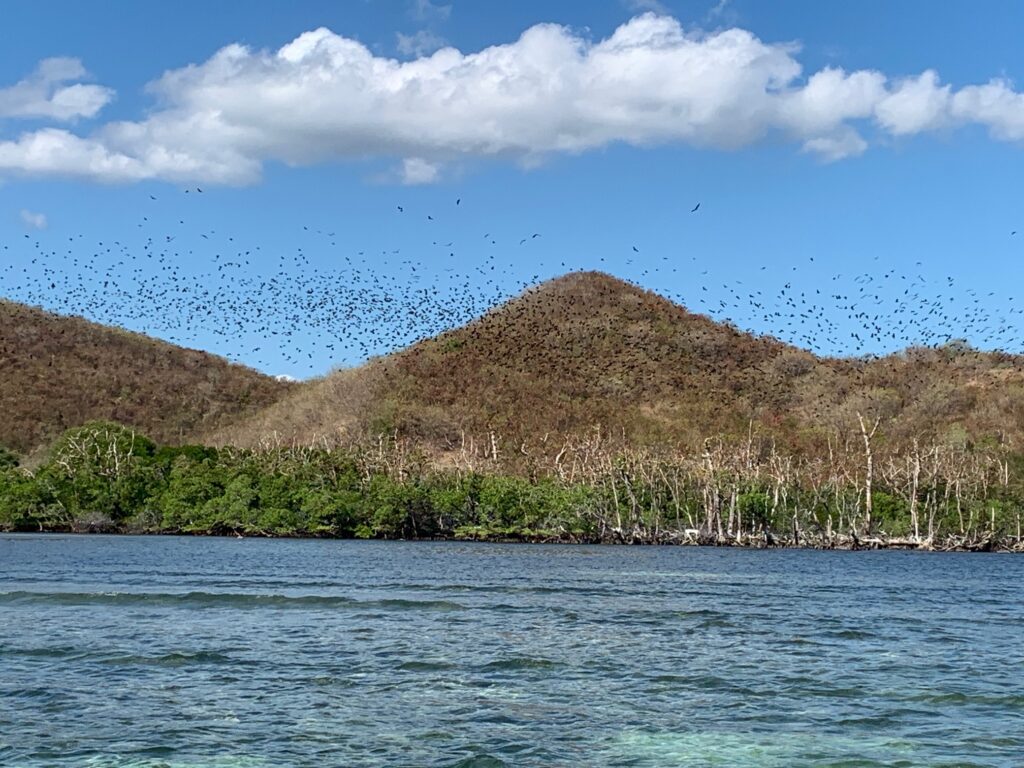

There were some colorful corals and marine life where we snorkeled off the boat on our second stop. The snorkeling area is shallow, especially on low tide. A six foot person can actually stand and his or her head would still be above water in most places. Of course, this can only be done on a sandy bottom (no standing on the coral). This would be the place in the tour where the most time should be spent. It has the most coral fish density compared to the remaining stops.
Palau Tembang, the third stop, has some shade trees. Each boat captain has their designated spot on the island to cook and eat lunch. There is also snorkeling off the island but the fish density is not as high as in the previous stop.
Palau Ruteng is the last stop. Palau Ruteng has a hill with a roofed viewing structure at the top. It provides a 360 degree panoramic view. Back at the beach, there are fish near the coral shelf but the water at the time we went was not clear. It seems that there were plankton in the water as there were schools of small fish just eating something in the water.
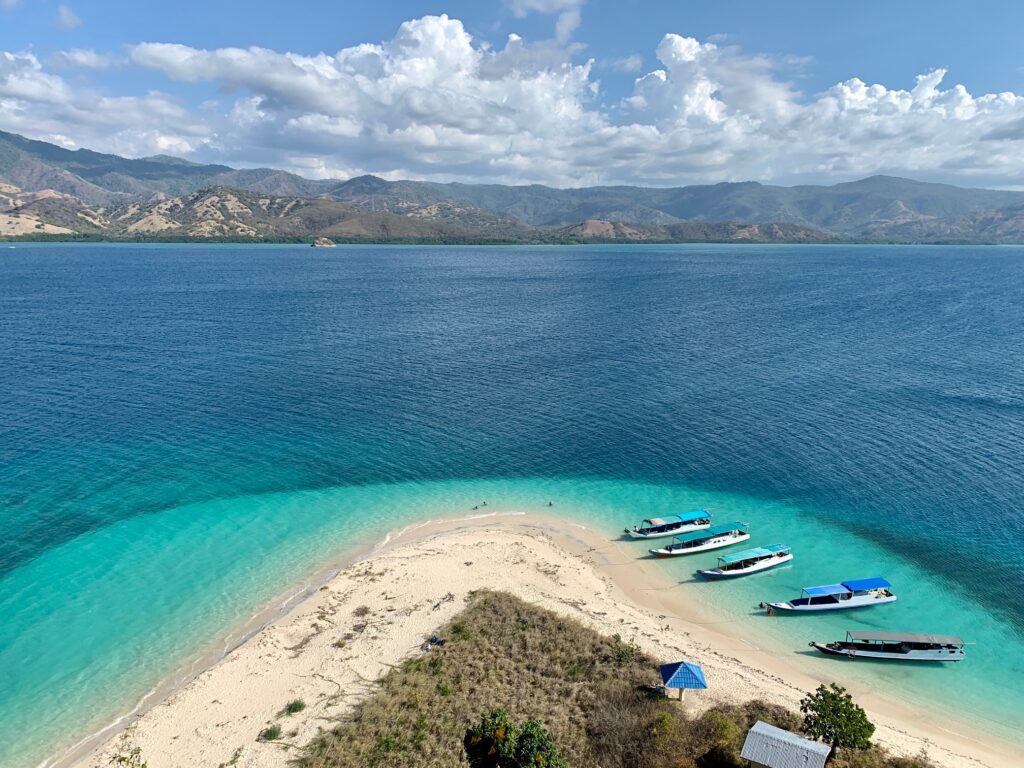

We rented a scooter on our second full day and decided to motorbike to Ampat Pohon homestay. The path was windy but it had some nice views. We took a dip in the river, partied briefly with the locals who were celebrating a child’s first communion and watched the sunset at Watu Mitung Viewpoint.
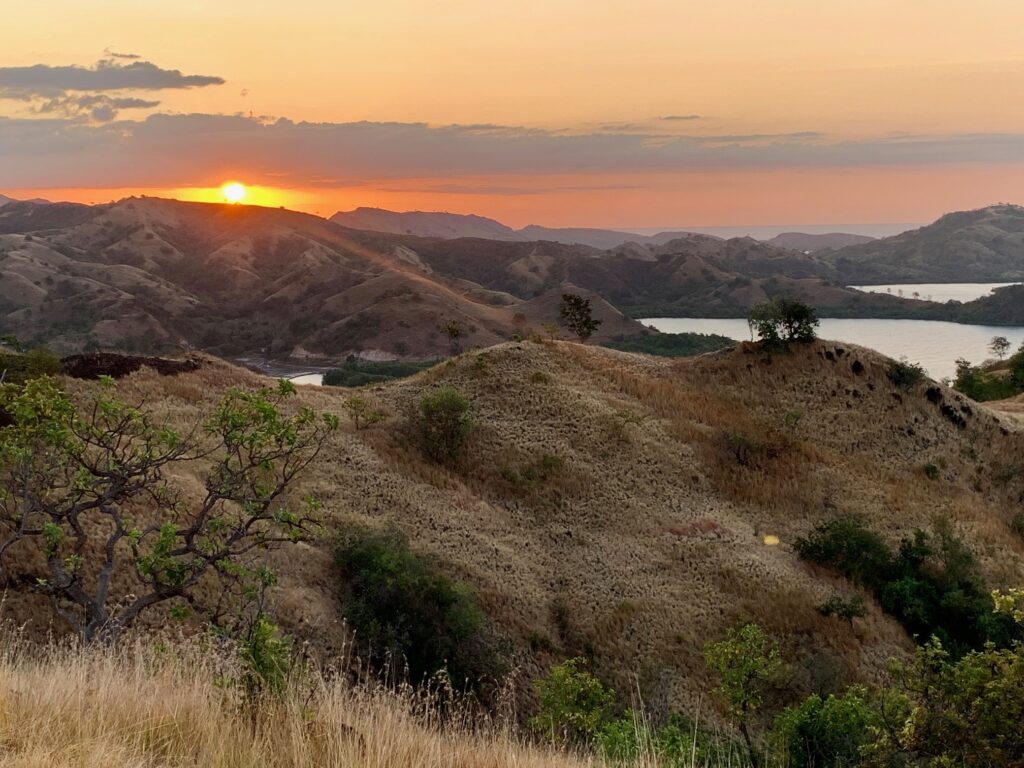

Ruteng
Most of the information we read online indicated that people stop at Ruteng just to break up the long travel between Labuan Bajo and Bajawa. So we just planned a one night stay at Ruteng. The Spider Web Rice Field is only a 30 minute motorbike ride from Ruteng. There is also the nearby Ruteng Pu’u Traditional Village.
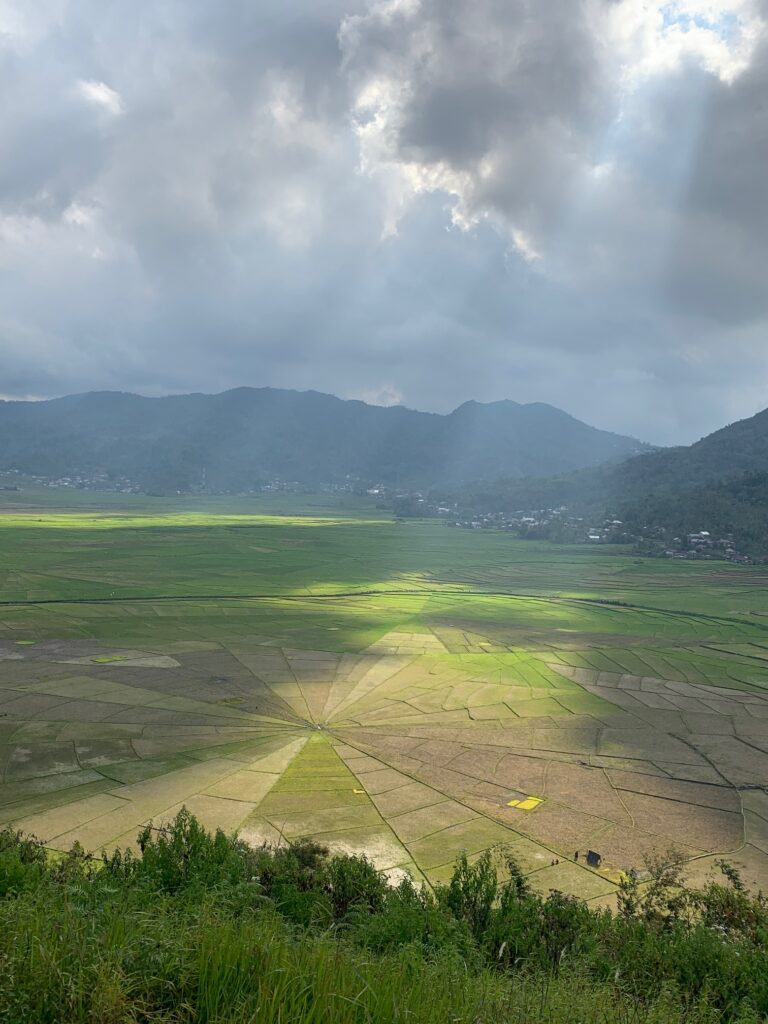

But in talking with other travelers, Ruteng can be a jumping off point to go to Wae Rebo Village. You will need to make an overnight stay at Wae Rebo as it is about a 3 hour motorbike ride from Ruteng. There are no roads to get to Wae Rebo. It is only reachable by foot, about a two hour trek according to a couple from Belgium that went there. Our host at Ruteng said that the trek used to be 9 kilometers and four hours. But the government built a road to the village of Dintor that cut the distance by half.
If Wae Rebo is too far for you, another similar village but less known is Todo Village. It is about an hour drive south and west from Ruteng according to GoogleMaps.
Just like Moni and Bajawa, Ruteng is at a higher elevation. The air is cooler here than in the lowlands.
Labuan Bajo and Komodo National Park
If you start your Flores adventure from the east, you will be unpleasantly surprised when you reach Labuan Bajo. The country feeling and sincere, warm and smiling people you experience at Moni, Bajawa, Riung and Ruteng are replaced with congested, noisy and touristy establishments and money hungry people. One local guide said that Labuan Bajo is expensive. Indeed it is, from accommodations to food and everything in between, everything is much higher. On a per person basis, the Komodo National Park boat tours are the most expensive tours we had, even more expensive than Raja Ampat.
Downtown Labuan Bajo is like Bali. Shops and restaurants line the main street. Tourists are everywhere during the high season. Motorcycles and cars zip by like there is no end in sight. For us, it is just one of those places we had to go but want to leave as soon as possible.
Most tourists go here for the Komodo National Park tour. The Komodo islands were brown and dry during the time we went. There are plenty of places that sell tours, from our hotel, to the lady at the warung and the numerous stalls that line main street Labuan Bajo. There are two kinds of Komodo National Park tours. One is a long day trip and the other is a multi day trip where you stay in a houseboat.
We did not do the houseboat because, first we did not know there was one before we planned our Flores explorations and two, our hotel was already paid in advance so we could not change our itinerary. We talked with other travelers that have done the houseboat tour and they liked it. Our Belgian friends that did the 3D/2N trip went to gotokomodo.com to book their trip. They said they paid 3M IDR per person.
There are two modes of transportation for the day trip. The first is the more expensive speedboat that makes six stops and the other is the cheaper slow boat that makes four stops. We talked to a couple that did the slow boat and their only complaint was the noisy engine. What they liked about it is that most of the tourists that did the speedboat had already left when they arrived at the destination. However, the slowboat carries about 20 passengers so don’t expect the place all to yourself. The starting quote we got for the slow boat was 600K IDR per person.
We decided on a speedboat tour. Our hotel offered a day trip for 1.3 M per person. We got two quotes from two different tour agents on main street Labuan Bajo. Their prices all start at 1.3 M also so it just boils down to negotiations. It seems that most agents represent the East Cruise company as they all have their brochure. We negotiated with Sanctum Komodo (an agent) and they knocked off 150K from the price. We said we wanted to go on the cruise the following morning.
We were picked up at our hotel around 6AM and were at the harbor about 30 minutes later. Then we waited for the next hour before our boat’s name was called. To our surprise, the luxury speedboat that was shown on the brochure was an old, in need of paint and rusting ferry caliber speed boat. Everybody in the boat that we talked to were all disappointed as we felt there was a bait and switch. Our guide in the boat said that people that make last minute reservations are normally assigned to the old crappy boat. He said that you need to reserve at least two days in advance, preferably five days, to get on the luxury speedboat. So we all felt like we were swindled but that is how life is, you live and learn.
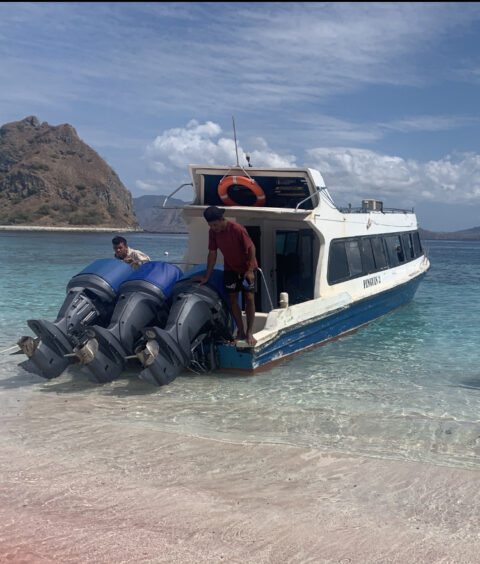

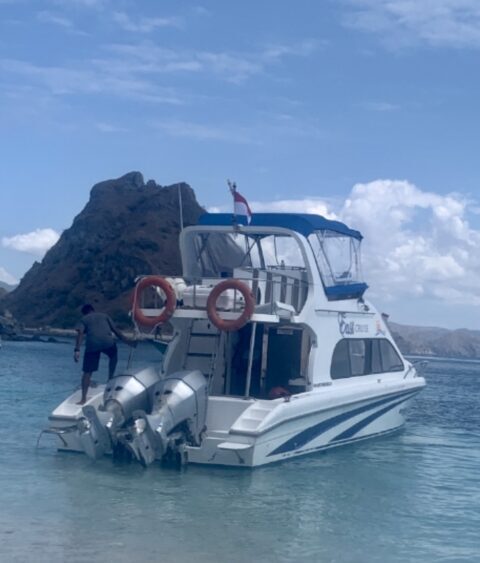

To wrap this section of the blog, the slow boat stops at Padar Island, Pink Beach, Komodo Island and Taka Makassar. The speedboat goes on to two more places which are Manta Point and Kanawa Island. Padar Island is where most people proudly post their Instagram photo of almost a bird’s eye view of the island with beaches to the left and right. You do have to tackle a lot of steps and maneuver through a lot of people to get to the Instagram shot. We had about an hour and a half at Padar Island.
Pink Beach does not need any explanation. The entire beach is not pink, only part of it. Still, it is not everyday you set your sights on a beach that has a shade of pink. Snorkeling is another activity at Pink Beach. We had a one hour stop here.
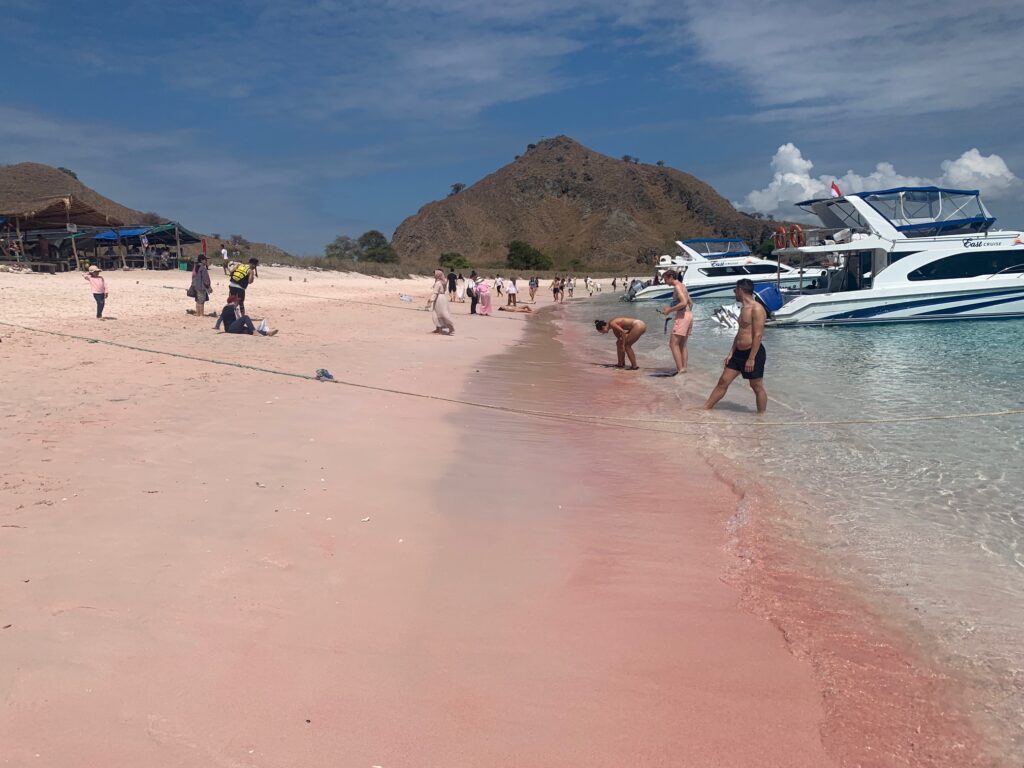

We consumed our packed lunch (provided by the tour organizer) in the boat on our way to Komodo Island. We were warned beforehand that seeing the dragons at that time of the year was slim to none. They hide in the jungle in June, July and August during mating season. We only saw one dragon in the two hours we spent walking in the jungle at midday with a naturalist guide. The park has artificial watering holes but our guide said that the dragons only hang around the watering holes in early morning and late afternoon (when it is cooler and the hordes of people have left). But other tourists we talked to said that they saw a few dragons. So it just boils down to luck.
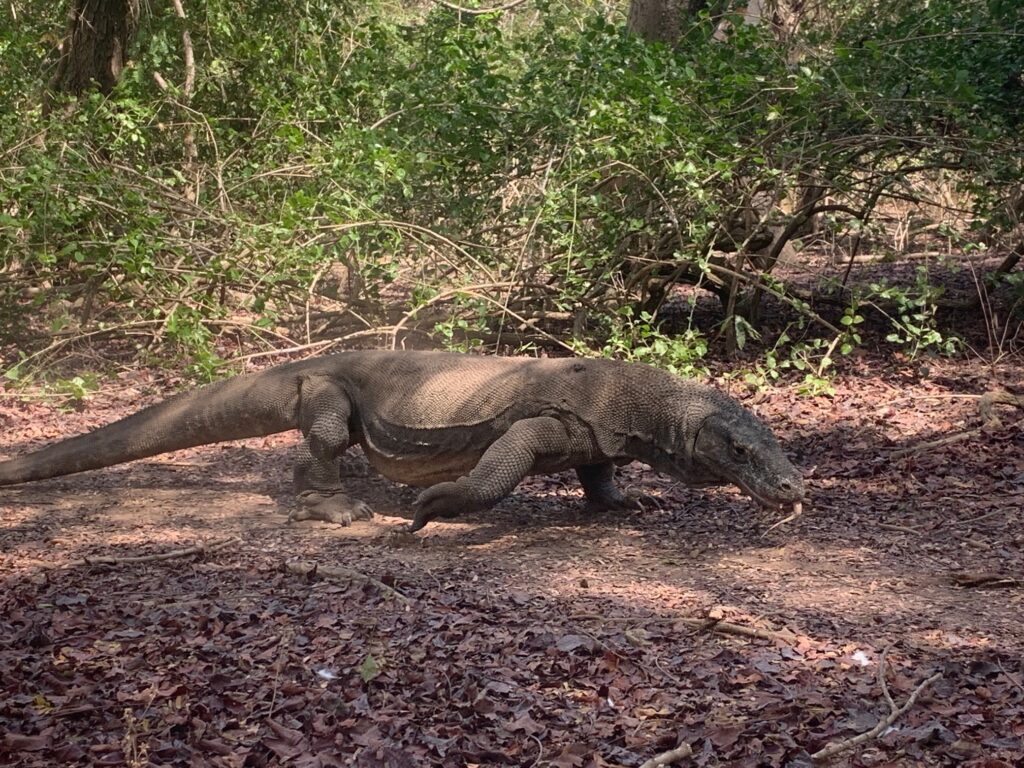

Taka Makassar is a small sugar white sandbar with a sprinkling of pink crystals. The water around it is crystal clear. You can see the bottom at 20 meters deep or more. There are corals and a long shallow beach. A really nice place to just soak or snorkel, except there are no shades.
Manta Point is where manta rays hang out. But unfortunately at that time of the year, they were not there. Our boat captain in Riung said that manta rays come when there is rain. The rainy season in most of Indonesia is December through February. This makes sense as mantas feed on plankton. We did not even bother jumping in the water as we were all tired at that point.
Kanawa Island was the last stop of our ferry speedboat tour. The water is clear around the island and there are seagrass. Our fellow passengers saw a couple of turtles. We just watched the sunset from the dock. It was a nice way to end the day.
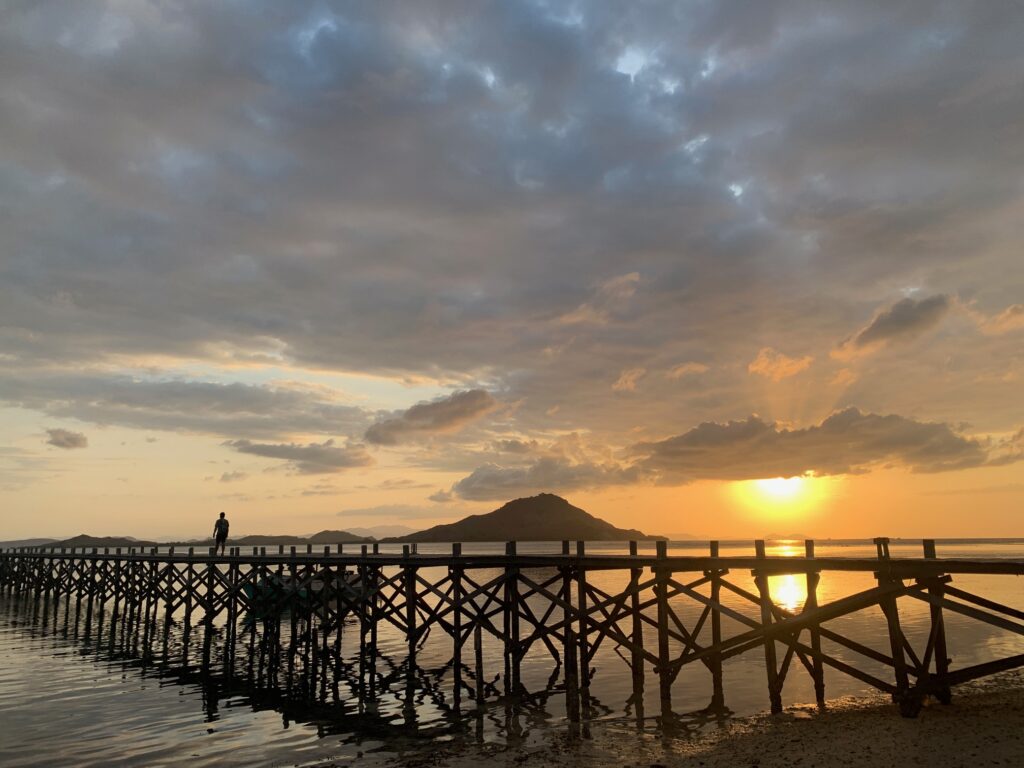

Where We Stayed
Moni: Rago’s Homestay
Rago’s Homestay is located about one kilometer south of Moni’s town proper. It is owned by Yohanes or we called him Jon. He named the homestay after his grandfather who he inherited the property from. He has three units with private bathrooms and was building an additional four more units during our stay. The bathroom is semi-outdoor with a nice touch of moisture loving houseplants. First of its kind of bathroom we encountered on our trips. The units do not have air conditioning but it was not needed as the evenings were cool up in the mountains. We actually had to cover up and it was cozy.
Jon is a wonderful host. He speaks good English so communication is not an issue. He loves talking to his guests. Jon is always smiling and laughing which makes you just want to talk to him. You can WhatsApp Jon directly at +62 813 3723 8533 if you need to make a reservation so you can save any additional fee from third party booking websites. While you are at it, you may want to ask Jon other things to see and do in and around Moni besides Kelimutu Lakes and if he can guide you. This way, you can assure yourself that you would not be cutting your visit to Moni short like we did.
Bajawa: Cinnamon Guesthouse and Maja Guesthouse
Both guest houses are located on the main road just before the town proper. Both are just a few steps from the corner of where the road from Ende meets the road going to Riung and Ruteng. Cinnamon Guesthouse had hot water while Maja Guesthouse did not. Our room at Cinnamon Guesthouse had a private bathroom while others did not.
The owner of Cinnamon Guesthouse is also named Yohanes and he treats his guests like his own brothers and sisters. He and his son spoke good English as well. Oching operates Maja Guesthouse which is owned by his father. Oching spoke good English as well.
The rooms in both guest houses are not uniform, meaning each room is different. We stayed in a nice room in Cinnamon and an OK room in Maja. But we saw other rooms that are a step down and a step up as well.
Just like Moni, Bajawa is also high in elevation and gets cool at night. Air conditioning is not needed but you may need a light jacket if you go out at night.
Riung: Sangrila
Our major gripes about this accommodation are that guest-staff interaction was minimal and there is no real Wifi. The Wifi is a personal hotspot from the owner’s cell phone. We managed to peek into one of the rooms at Cafe del Mar and the rooms were big city hotel caliber nice. Without a doubt, Cafe del Mar would be the place to stay if the budget permits. Our friends stayed at Riung GuestHouse and they said it was a nice guesthouse, except that there was a party happening in the guesthouse during their stay.
Ruteng: Ara Garden Inn
Ara Garden Inn is an upscale accommodation. It is reflected in the price as well. The rooms are large and modern. It is a nice change to feel some luxury after being in homestays. The staff are friendly and spoke English. The only downside of Ara Garden Inn is it is far from the main part of town so you have to rent a scooter.
Labuan Bajo: Bintang Flores Hotel
The hotel has a swimming pool by the beach. It faces west so you can view the sunset while lounging in one of the chaise by the pool. The rooms are big but their bathrooms are dated as they still use shower curtains. Their breakfast buffet has more to be desired. However, the marina and touristy part of Labuan Bajo is only a 30 minute walk from the hotel.
Summary
Besides Raja Ampat, Flores is probably one of those places that we would like to go back to. It is raw and undeveloped, except Labuan Bajo which is just another touristy town like the whole of Bali. But beyond Labuan Bajo, there are many nooks and crannies and islands to explore. We miss Flores’ warm, smiling and happy people (except Labuan Bajo). It seems that they are just happy to see you regardless of where you come from.
Expect to travel on winding roads to get from one town to another in Flores. Grab has only reached Labuan Bajo and is not available anywhere else in Flores. Even the Grab in Labuan Bajo only offers motorcycle rides. The best way to get to your next destination is to have your host arrange the transportation. We did not have to travel by public bus as it takes too long due to the number of stops. “Public” was our main mode of transportation. You may want to look up the company Travel and Bus Pariwisata as they have comfortable seats and do not cost much more than “public” cars.
Moni, Bajawa and Ruteng are in the mountains and are cooler than Riung and Labuan Bajo which are by the sea. No air conditioning is needed in the mountain but make sure your accommodation has hot water unless you want to take a refreshing shower. The opposite is needed at Riung and Labuan Bajo where you will need air conditioning and a cold shower.
Kelimutu Three Crater Lakes Complex is astounding. There are more places still to explore in Moni than what we just mentioned in here. Bajawa is the same thing. Visiting the traditional villages is like stepping back in time. The Manalage Hot Springs beckons us to come back for that refreshing hydro-massage. And we will never forget the view from the Wolobobo Viewpoint.
Riung is a small community that is the gateway to 17 Islands National Park. Walking the streets of Riung is a very nice change from the hustle and bustle of Labuan Bajo. It is just quiet out there except when there is a wedding.
Ruteng is a good base to see the spider web rice fields. In pictures, the rice fields may not look that great but pictures do not do justice to its beauty. You just have to see to understand what we mean. Ruteng can also be the jumping off point to see Wae Rebo and Todo Traditional Villages.
Labuan Bajo is not like the rest of Flores. It is more like Bali where it is commercialized and full of people. It is the gateway to Komodo National Park which we would not mind seeing again during the lush season. The tours here are the most expensive on a per person basis compared to the other boat tours we had in our almost two months in Indonesia.
